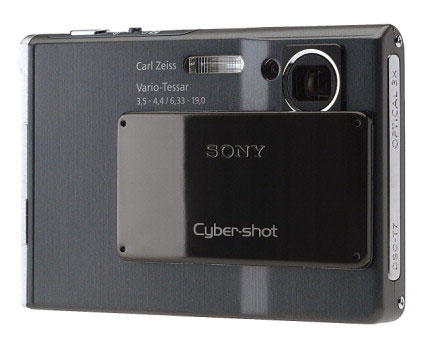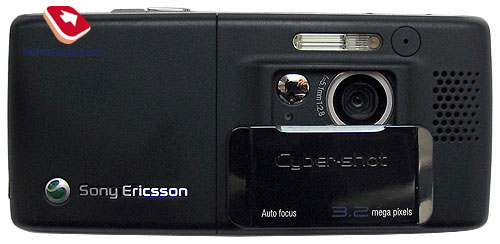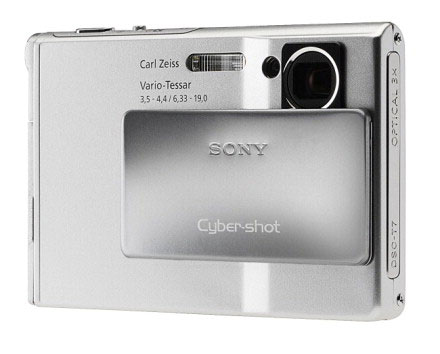|
|
Review of GSM(UMTS)-handsets Sony Ericsson K790/K800 – Part One
Official
Photos>>>
Live Photos>>>
Review
of GSM(UMTS)-handsets Sony Ericsson K790/K800 – Part One>>>
Review
of GSM(UMTS)-handsets Sony Ericsson K790/K800 – Part two: design,
display and technologies>>>
Review
of GSM(UMTS) phones Sony Ericsson K790/K800 Part 3: Photographic>>>
Review
of GSM(UMTS) phones Sony Ericsson K790/K800 Part 4, or What’s new
in interface?>>>
Review of
GSM(UMTS)-handsets Sony Ericsson K790/K800 – Fifth Part, the conclusion
Interface and all standard functions>>>
This material is unusual in its construction – as our permanent
readers might already know, this means we are going to place high
emphasis on the product due to its specifications. This article
consists of several parts and your attention should be draw firstly
to the one describing the camera, since its characteristics are
a major breakthrough to date. The decision of merging two reviews
into one was dictated by almost complete identity of the handsets.
Prehistory, marketing prerequisites Forming of Sony Ericsson
product line has been followed by many hardships lately – absence
of a wide line-up and availability of only a few best-seller models
saving the sales haven’t let the company lose initiative. Having
acquired taste for “ultimate”-solutions in certain fields, Sony
Ericsson left out product line variety and until 2005 hadn’t released
any modifications of its devices. Launch of Walkman series, featuring
minimal differences from Sony Ericsson K750i, was an experiment,
though very ambitious. – in the end it turned out to be a success
and the company decided not to shut down twin handsets projects
for some of the upcoming devices. In all respects average sales
of original models of the new series, like Sony Ericsson W550i,
were a powerful incentive to focusing on those, alternative solutions.
But to tell the truth, W550i had materialized as a result of increasing
S600 functionality, which in its turn was dropped out later on.
The entire idea of twin projects in many respects was borrowed from
the successful attempt of forwarding Series 40 by Nokia, when some
solutions saved the sales of models with average functionality.
And here the factor of users getting used to a certain quality of
functions’ realization steps in, as brand loyalty begins to shape.
That’s why popularity of Sony Ericsson K750i made it possible for
W800i to become a hit and raise overall sales of this platform.
At the same time, it was essential for Sony Ericsson to balance
between amount of new and twin models, in order not to turn into
a company, manufacturing devices of the same kind, but with various
indexes. At this point in time, this issue is being solved by an
exclusive know-how – introduction of different trade marks, handed
down from Sony. In fact every single brand brings a device out of
the product line and creates a new line-up. Actually this is becoming
a world-wide tendency in the field of mobile phones – remember Eseries,
Nseries by Nokia, or four-lettered indexes of handsets by Motorola
and corresponding product lines, based on them. The most outstanding
Motorola’s representative of this tendency is RAZR line-up. However
BenQ Mobile can’t keep up with this, as after the recent reorganization
even its employees are afraid of entangling in countless abbreviations.
In the end of 2006 the Korean manufacturers are going to release
separate line-ups and position them in a different manner as well.
Those, who managed to claim the title of pioneers in this sphere,
will earn a small fortune on this in the future. In case of Sony
Ericsson, the first stage featured the popular in the past brand
of Walkman – with the help of several new devices the company managed
to get its recognizability even higher. The next logical step appeared
in the form of a respond to Nokia’s attempt to position a number
of its devices as purely photographic ones – as a matter a fact,
this threatened Sony Ericsson K750i sales, which had already proved
to be a solution aimed at portable shooting with the best picture
quality among all mass handsets. The first product of this kind
by Nokia featured glass optics, picture quality, comparable with
Sony Ericsson K750i and co-branding with Carl Zeiss. The synergetic
effect caused by Nokia and Carl Zeiss brands tying up was so enormous,
that there were some serious debates between our readers. As to
me, everything turned on marketing, since specifications of these
two handsets were evenly matched. The product by Sony Ericsson and
its following variations couldn’t boast of famous brands – their
main advantage was the best combination of price and quality. Thus
in order to secure itself against attempts of other manufacturers
to achieve advantage via synergetic effects in the future, Sony
Ericsson reached an agreement on incorporating CyberShot technologies
into its products. In fact, it had been used by Sony since 1996
and actively promoted along with digital cameras – the raising popularity
of which increased recognizability of this trade mark. In the end
of November 2005, the brand of CyberShot placed third in Landor
agency’s all-round rating, which featured brands from all fields
(the first place was given to Google and LeapFrog was the runner-up).
The widely known iPOD managed to hit only the 8 place. I, by no
means, agree or disagree with the results of this research, though
I have to mention that this trade mark is very popular. By using
this trade mark in its products, Sony Ericsson will increase brand
loyalty, and that’s exactly what the company needs. And if they
can support usage of this brand with outstanding specifications
of the upcoming model, the synergetic effect will be heavy. Acting
in advance I would like to note, that the process of merging with
Sony’s brands will continue in the near future – moreover it seems
that PlayStation is next in turn, as vertical integration of PlayStation3,
PSP and several new models by Sony Ericsson is already scheduled.
When I was writing this article, I came across a very
interesting material on CyberShot brand advent, and now I call
your attention to it.
One of the essential conditions of successful model is mimicry
with known products of different brands. When Sony Ericsson signed
up CyberShot trade mark, the back panel of the handset was remade
as much as possible in order to fit the camera. The shutter, the
flash and other parts are so similar to the “slim” line-up of digital
cameras by Sony that one can marvel upon.



From describing stories of various brands and reasons of their
materialization in the models of Sony Ericsson line-up, let’s get
straight down to a question not less interesting. Why are we reviewing
two models at once? In order to answer this question, let’s remember
what the major complaints of Sony Ericsson users were in the year
of 2005 and today. For many the sticking point was absence of EDGE
in the device – this technology is gathering pace nowadays, however
according to a research its relevance during the last year was dubious.
Nevertheless the consumers have begun proceeding from this parameter
as well when choosing a handset – that’s why it has to be taken
into account as well. For potential buyers the company released
Sony Ericsson W810i, therefore should you need EDGE and a number
of upgrades – pick this solution. But there is the other category
of people who are not desperate for EDGE, but want all functions
of K750i to materialize in a model aimed at UMTS-networks. The attempt
to gather all these requirements in one product led to rise in its
price and dependence on supplies of chipsets with incorporated EGDE,
though over the last year the market suffered from deficiency of
these (the same Motorola will apply EDGE to mass handsets only starting
from the latter half of this year, even though all devices were
introduced with this technology onboard in the first place). It
was unacceptably for the company, thus we didn’t see the release
of an updated K750i version after all, although it could appear
on the shelves (with EDGE support and improved camera’s module).
On the new developmental stage, the company took a decision to
use two hardware platforms at a time - B200 and D400. The former
one is aimed at UMTS networks and adopts a frontal camera, while
the latter one operates in common GSM-bands, doesn’t have a frontal
camera and features EDGE. Wilma (later on received K800 index) represents
senior devices, and Evita, in its turn, is a junior model K790.
The difference in titles should have resulted in price distinction,
but the company fairly considered that these two handsets are aimed
at a bit different audiences and evened up price on two devices.
This is a rather daring experiment, and from my point of view it’s
more likely to be a success, because the models are equal in terms
of interface and technical characteristics.
These devices were expected to be introduced into the market a
bit later and a number of specifications would differ from the current
state of things: in particular they had anticipated a renovated
interface featured in both models. However nothing of this did happen,
since the manufacturer decided not to let Nokia 6233 rule the forming
market of business-handsets. But at the same time the number of
innovative technologies in these two models is enough to consider
them as top models of the line-up. All mistakes regarding shipments
of Sony Ericsson K750i were considered and concluded, therefore
a Chinese plant prepared large consignments of both models and once
they are officially released, no one will experience lack of these
handsets. This will let avoid deficiency and in a short period of
time reach the recommended prices, set on majority of markets.
In
the next part we’re going to reveal the design of the devices, constructional
peculiarities and displays.
Eldar Murtazin (eldar@mobile-review.com)
Translated by Alexander "Lexx" Zavoloka (alexander.zavoloka@mobile-review.com)
Published — 28 February 2006
Have something to add?! Write us... eldar@mobile-review.com
|
News:
[ 31-07 16:21 ]Sir Jony Ive: Apple Isn't In It For The Money
[ 31-07 13:34 ]Video: Nokia Designer Interviews
[ 31-07 13:10 ]RIM To Layoff 3,000 More Employees
[ 30-07 20:59 ]Video: iPhone 5 Housing Shown Off
[ 30-07 19:12 ]Android Fortunes Decline In U.S.
[ 25-07 16:18 ]Why Apple Is Suing Samsung?
[ 25-07 15:53 ]A Few Choice Quotes About Apple ... By Samsung
[ 23-07 20:25 ]Russian iOS Hacker Calls It A Day
[ 23-07 17:40 ]Video: It's Still Not Out, But Galaxy Note 10.1 Gets An Ad
[ 19-07 19:10 ]Another Loss For Nokia: $1 Billion Down In Q2
[ 19-07 17:22 ]British Judge Orders Apple To Run Ads Saying Samsung Did Not Copy Them
[ 19-07 16:57 ]iPhone 5 To Feature Nano-SIM Cards
[ 18-07 14:20 ]What The iPad Could Have Looked Like ...
[ 18-07 13:25 ]App Store Hack Is Still Going Strong Despite Apple's Best Efforts
[ 13-07 12:34 ]Infographic: The (Hypothetical) Sale Of RIM
[ 13-07 11:10 ]Video: iPhone Hacker Makes In-App Purchases Free
[ 12-07 19:50 ]iPhone 5 Images Leak Again
[ 12-07 17:51 ]Android Takes 50%+ Of U.S. And Europe
[ 11-07 16:02 ]Apple Involved In 60% Of Patent Suits
[ 11-07 13:14 ]Video: Kindle Fire Gets A Jelly Bean
Subscribe
|


